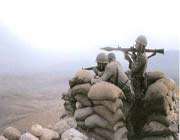Fath-al-Mobin offensive operation (The second Karbala operational plan) (March 22nd, 1982)

After 18 months of war between Iran and Iraq and implementation of tens of small and great attacks by the two sides, the balance of power was tilted towards Iranian forces condition. Accordingly, Iranian commanders included a swift liberation of occupied lands in their planning. Iraq had made the most extensive land turnout in Shush area and west of Karkheh. Some parts of Dehloran on the north extending to Tang-e-Roghabiyeh in the south of battlefight, 70 to 80 kilometers deep in Iran had been occupied by Iraq. Although there was no strategic point or key terrain in this area, the threat against Andimeshk - Ahwaz axis and the location of Shush, Andimeshk and Dezful cities being within the range of enemy’s artillery fire were among unbearable issues. Friendly forces displaying severe resistance against the enemy and taking advantage of Karkheh River obstacle accompanied by serious attempt made by artillery units, army Aviation and hero Air Force stopped Iraqi forces advancement in October, 1980. Iranians could not only suppress the enemy in the west of the river but maintain the beachhead of Karkheh Naderi, Shush region and by performing Hendeli channel; Tappeh Cheshmeh and Angoosh operations could deploy a considerable number of forces in the west of Karkheh.
In the continuation of the events in this region, Iraqi’s attacks resulted in failure too and due to the rupture of connection among Iraqi forces in the area of Bostan, the ground was prepared for an extensive operation on the part of Iran. A joint headquarter by the name of" karbala operational headquarter “was established in Iran. Its main goal was to draw the attention toward the principle of "Unity of command” for the holy integration between Army and Revolutionary Guard Corps.
In keeping with this initiative, Iraq’s movements on February 6th, 1981 in Tang-e-Chazzabeh and Bostan region on March 20th, 1987 in Shush area are remarkable.
By dispersing the Iranian troops, Iraqi forces intended to prevent a large operation in Shush area and press ahead with their presence deep in Khuzestan’s soil. Fath-al-mobin operation whose name was inferred from Holy Qur’an and its sacred verse of" we will bring about a decisive victory for you " was launch 30 minutes after midnight on march 22nd , 1981 with the code of" ya Zahra(PBUH) and after seven days of battle it came to an end on march 29th, 1981. Accordingly, one of the largest and most extensive land operations occurred between Iraq and Iran. Qods, Nasr, Fajr and Fath headquarters engaged with enemy, from north to south, in Ein-e-Khosh and Abu qarib , Ali gereh Zad and Tappeh belta and tineh heights , Abu salibi khat hills to chananneh, and east of Mish Dagh heights and Roqabiyeh respectively and during three stages after crossing the defensive positions, could commence their advance deep inside Iraqi postions and deploy around the border heights.
Late Imam Khomeini’s role in the final decision-making process and the issuance of command for the implementation of operation was important and determinant. His role caused high-ranking commanders from Army and Islamic Revolutionary Guard Corps to trust in God and then accomplish the operation. Major general Naqdi, one of the Army’s brave commanders, was granted martyrdom in this area.
Result:
-Liberation of some 2200 square kilometers from Iran’s territory.
-Einhkhosh area, Bclta, Shaveriyeh, Ali Gerehzad. Abou Salibi Khat. Tineh, Mishdaq heights and Abou Ghoraib oil wells and Barghazeh were liberated.
-25000 were either killed or wounded and 16000 captives were among Iraqi forces heavy casualties.
-270 tanks. 150 personnel carriers. 6 fighters, 3 choppers wore destroyed.
-150 tanks, 170 personnel carriers, 125 guns, 500 brand-new vehicles, thousands of light weapons, equipment and communication devices were confiscated by Iran.
Source:
Atlas of Unforgettable Battles (Ground forces operations in eight years of holy defense)
Compilation: Staff Colonel Mojtaba Jafari
Other links:
Hills of Angoosh offensive operation (May21st, 1981)
Kheibar (Quch-Soltan) offensive operation (May 26th, 1981)
Quch-Soltan defensive Operation (June 7th, 1981)
Imam Khomeini commander-in-chief offensive operation (June 11th, 1981)
Mahshar - Abadan road offensive operation (June 21st, 1981)